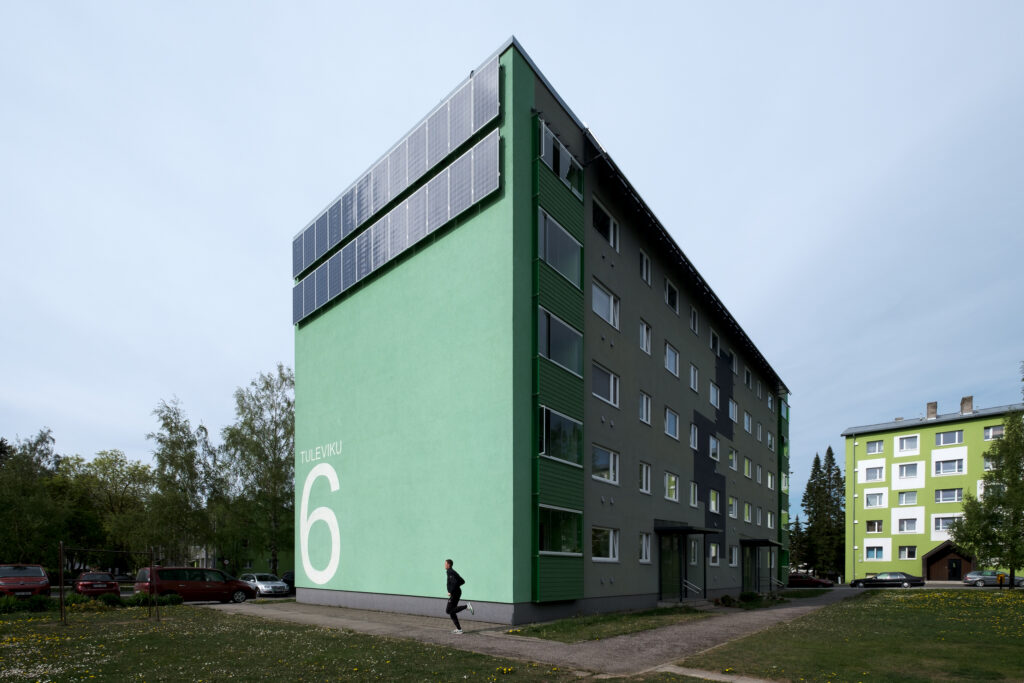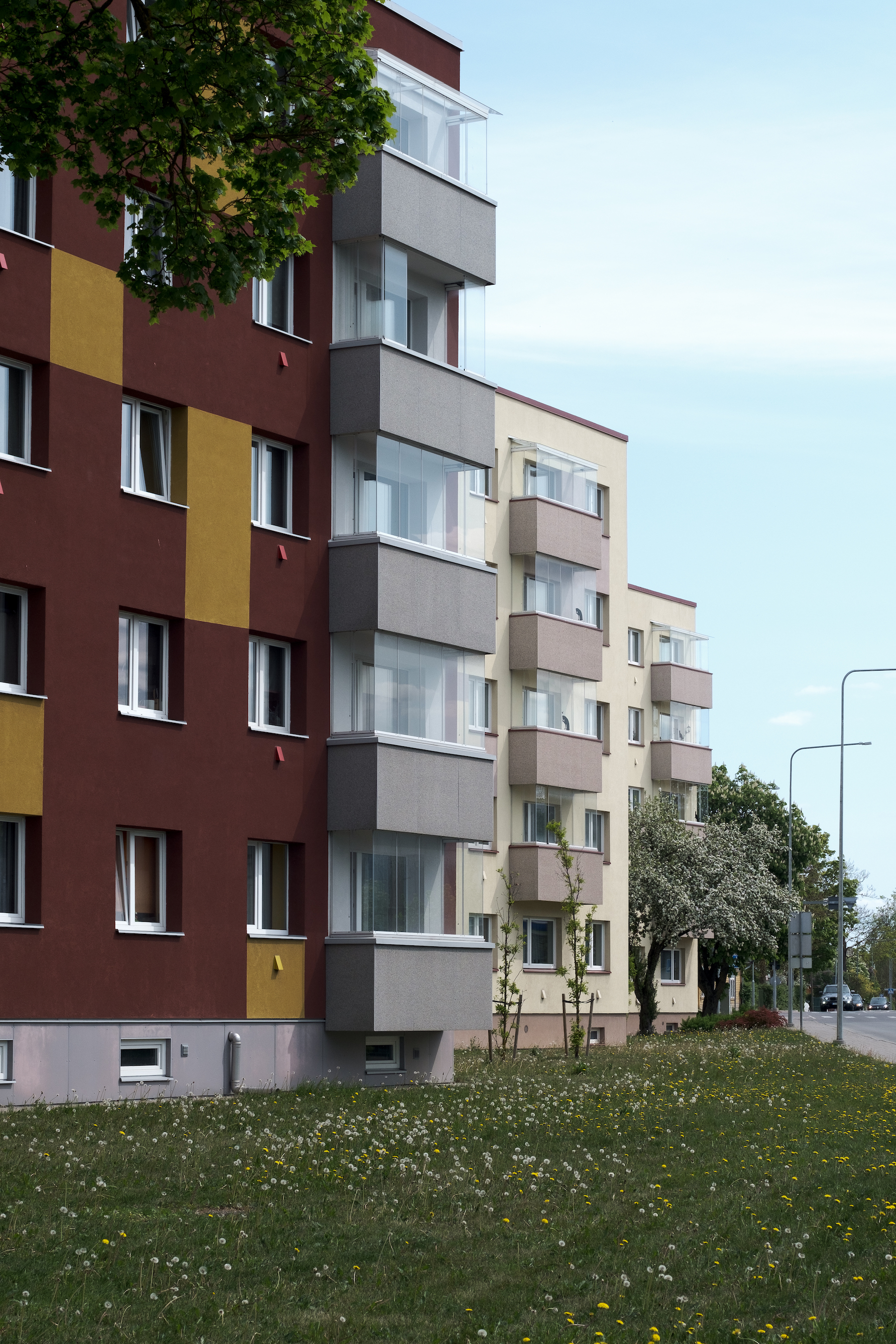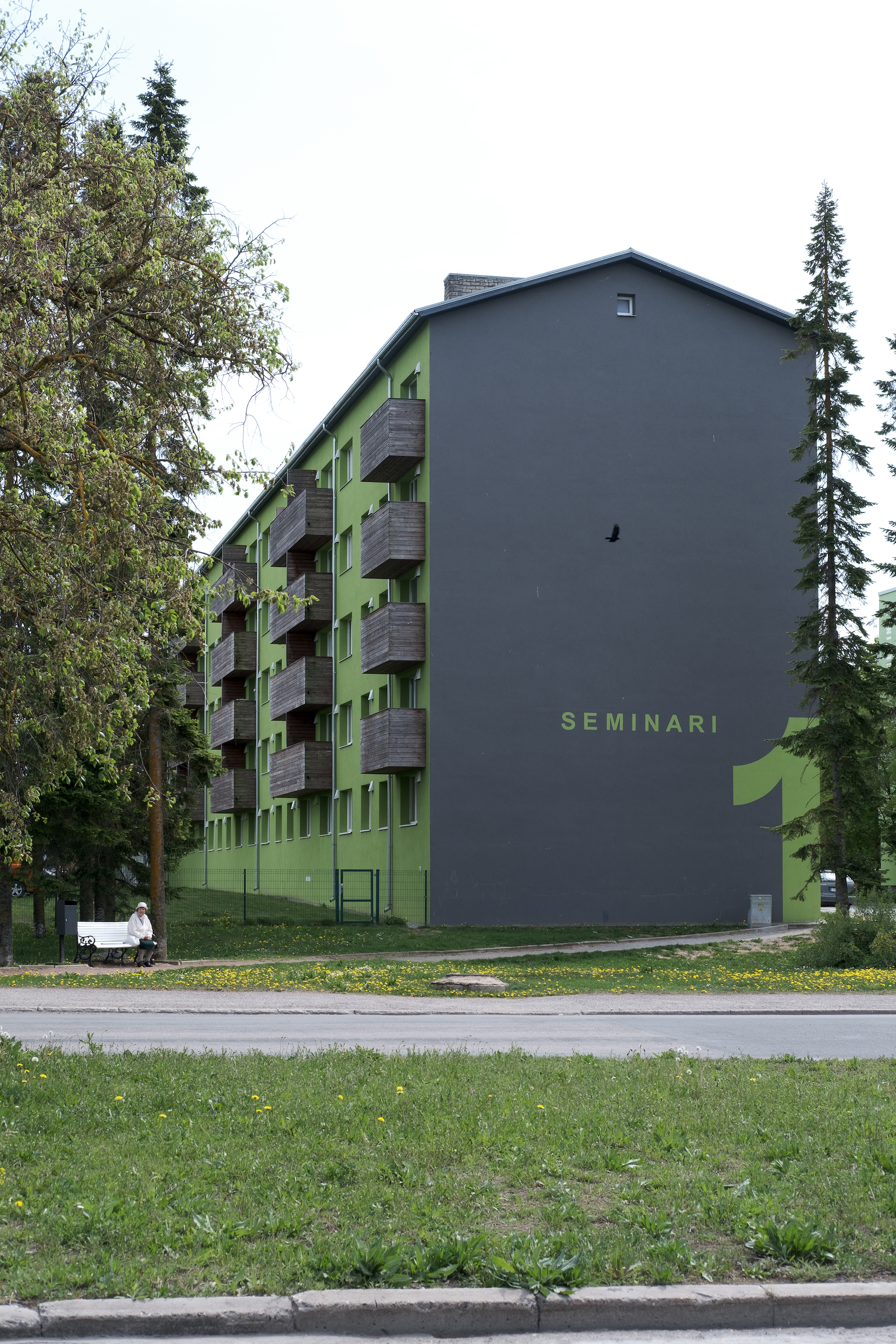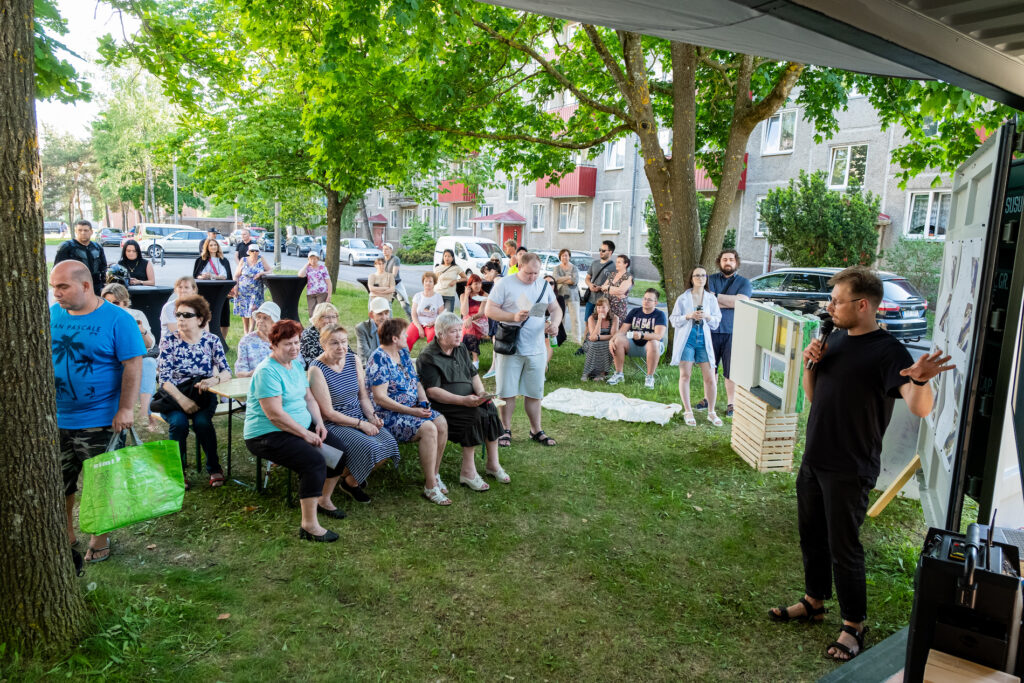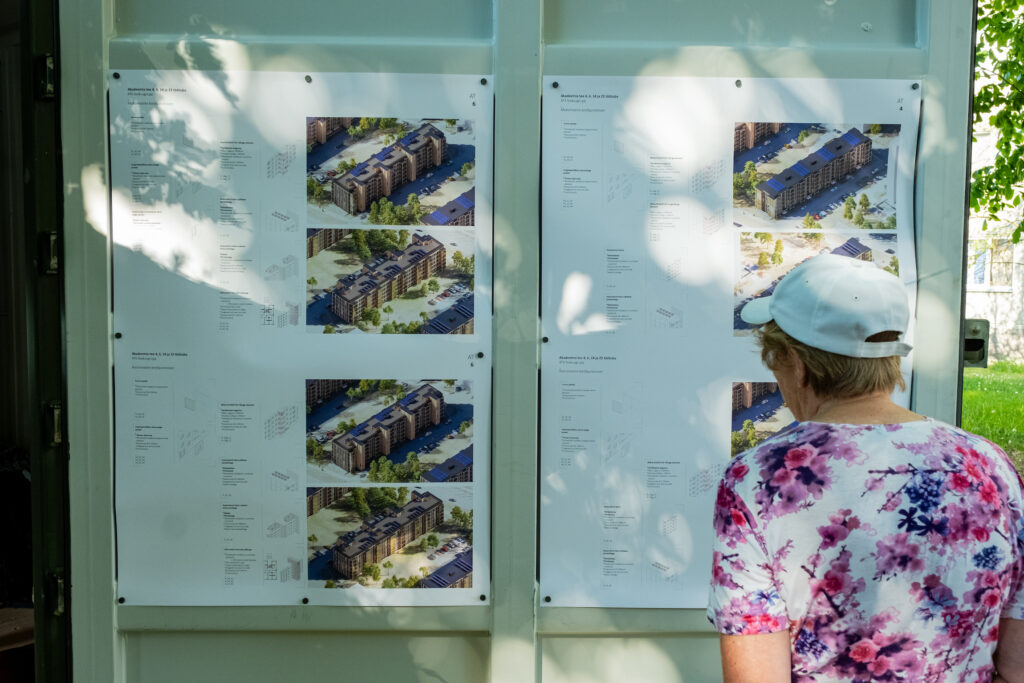For nearly 15 years now, Estonia has been undergoing a vigorous renovation wave, on the crest of which several thousands of apartment buildings have been fixed up. The renovation wave has been most strongly influenced by the energy and climate policy of the European Union and its long-term goal of decarbonising the housing stock across Europe by the year 2050. CO2 quota trading and European Union transition funds have helped to fix up about 1700 apartment buildings (with nearly 60,000 dwellings); 1000 of them saw major renovations.
At the same time, it is estimated that a couple of thousand apartment buildings have also been renovated without support from grants.1 The share of grant money in renovation projects is large—on the average 30–50%. Such large-scale interventions in the market mostly lead to expected results, but there can also be unintended side effects. On the backdrop of successful energy efficiency renovations, one can also notice two worrying trends—residents moving out either due to a lack of renovation, or due to renovation.
Let’s move out, for the building will never be renovated
At first, when the apartment building renovations began in 2010, grants were continuously available for several years, but in the last ten years, they have been snatched up quite quickly. This suggests a widespread interest in fixing up one’s building and reflects the fact that grants are cyclical. At the same time, the cost of a comprehensive renovation is high and it presents a challenge to the organisational skills and unity of apartment associations. From those buildings where the opponents of renovation outnumber the proponents, some residents have relocated only due to the fact that any renovation is unlikely to take place there. They also reason that selling their apartment in an unrenovated house might become much more difficult in the future.2
Renovation is heavily supported by grants, and the proponents have a strong desire not to miss out, so a higher probability of complete renovation is a rather rational reason for relocating. Proponents of complete renovation often find it insufficient if the building is renovated in a piecemeal way—for instance, by gradually replacing the technical systems. Their expectations for the quality of life and look of the building are much higher and more urgent. Thus, they move out and find new homes in buildings where there is a positive attitude towards renovation, or buildings that have already been fixed up. Some wealthier residents also move into newly-built buildings.
The trouble begins with those who will replace the ones moving out due to the lack of renovation. It is likely that the new residents do not consider renovating important or even consciously chose the kind of building where no larger investments would be made. Thus, such relocation decisions might over time lead to segregation based on attitudes toward renovation. This in turn means that certain buildings will have even more opponents of renovation and will be even more difficult to renovate in the future. At the same time, the old building keeps decaying and its renovation becomes increasingly expensive.
A study focusing on Tallinn showed that segregation between ethnic and occupational groups is the lowest in unrenovated buildings and highest in new buildings.
A study focusing on Tallinn3 showed that segregation between ethnic and occupational groups is the lowest in unrenovated buildings and highest in new buildings. Segregation was calculated based on the data from the 2011 census, which preceded the launch of support measures for mass renovation. Thus, the renovation wave has not affected the current state of segregation—residents were distributed in this way already before. This in turn implies that high segregation is not a consequence of renovating, but rather a precondition for renovating. This phenomenon should be examined further, as it suggests that homogenous communities are more likely to reach a joint decision than mixed communities.
According to the analysis, renovated buildings currently have more residents with higher paying jobs. A comparison with unrenovated buildings suggests significant structural differences between communities. At the same time, renovated houses also show a high segregation of residents with low-paying jobs. This means that certain renovated buildings draw together residents who earn less. The level of wealth strongly affects the extent in which there is readiness to renovate, which is why ambitions can greatly vary. Therefore, the less wealthy might find it easier to reach a joint decision on, say, fixing the heating system. Decisions in the conditions of greatly varying ambitions seem to be governed by principles described in the collective action theory, which explains the processes of reaching joint decisions in a community. Among other things, it describes how communities react to fair distribution of common and personal benefits. This theory could be further adapted and applied in explaining the renovation decisions of apartment associations.
Let’s move out, for the building was just renovated
The other tendency for which there is currently only anecdotal evidence in Estonia is supposedly that residents are relocating after their building has been comprehensively renovated. It is highly likely that no renovation decision is fully consensual. There will always be some residents who find that (complete) renovation is not reasonable or necessary. The most widespread concern for the opponents of renovation certainly consists in overwhelming future loan repayments. The apartment association can decide on a large investment without all the residents agreeing to it—agreement from half of the apartment owners is sufficient. This in turn means that vulnerable residents might be forced to give up their apartments due to the resulting large loan repayments and look for cheaper replacements in the market. This sort of process is called gentrification, which over time leads to renovated buildings becoming filled with higher-earning residents.
The aforementioned case study of Tallinn3 neither confirms nor refutes the assumption of gentrification, for it does not look into the population dynamics before and after renovation. However, studies elsewhere in Europe have indeed found evidence for a connection between gentrification and renovation. For instance, a case study of the city of Gdańsk in Poland5 revealed that forced relocation caused by the renovation wave has a much larger scope and impact than relocation caused by so-called regular gentrification, and the climate-saving agenda with its funding both fuels and justifies this process. Since the time of its publishing six years ago, the paper has already gotten over 100 references, and the range of examples where the green transition forces residents to relocate is only growing. It is probably high time to take a closer look at how renovation is affecting vulnerable groups in Estonia, and whether and how it should be regulated.
Vulnerable groups—young families and solitary retirees
Renovation-related growth of housing expenses affects primarily two groups. The first consists in young families who have bought their apartments with a mortgage. Let’s take the example of a three-room apartment in a typical Soviet-era apartment building. Factoring in the energy savings from a complete renovation and the additional loan repayments for it, the monthly expenses increase by 170 euros after renovating. This means that the young family needs to find each year an additional sum equal to one average monthly salary to pay the loan.6 This can be a serious challenge and might force the young family to relocate.
The second vulnerable group consists in seniors whose only income is their pension. The situation is especially difficult for those seniors who live alone in a large apartment. Unlike young families, seniors tend to be homeowners and do not have to worry about repaying a mortgage. On the other hand, the income of a solitary retiree is significantly smaller than that of a young working family—the renovation-related increase in housing expenses for a three-room apartment would amount to 22% of the average pension. By exchanging the three-room apartment for a one-room one, however, the renovation-related increase in costs can be significantly reduced. Complete renovation related loan repayment for the owner of a one-room apartment is 80 euros per month (meaning a 10% increase in housing expenses), which is proportional to the recent pension increase. Downsizing the apartment means extra money from the sale of the larger one that can be used for fixing up the smaller one and compensating for the increase in the cost of living, but it also means a change in the way of life, which is why this solution might be unsuitable for many seniors.

SOFTacademy, an external project of the city of Tallinn, is the first neighbourhood- based renovation project, which focuses on apartment buildings 3, 5, 14 and 22 Akadeemia Road and the shared courtyard between them. The engagement process is multilingual and residents are informed via both digital and physical channels—there is a trilingual information booklet about renovation decisions (in Estonian, English, Russian; distributed digitally and also in the form of physical copies in staircores); decision-making at apartment association meetings was aided by an Estonian-Russian interpreter; the survey to gather input for the renovation was bilingual (in Estonian and Russian).
Photo: Aron Urb
Increase in the property value
But how does renovating affect the value and price of the apartment? One of the most common arguments among the proponents of renovation is based on the assumption that after you renovate, the value of your property increases. There have also been articles in the Estonian media about how renovating increases the value of apartments.7 Unfortunately, most of these claims are just estimations. It is hard to find sufficient data-based evidence in Estonia that would show whether and to what extent the apartments in renovated buildings are more expensive than those in unrenovated ones. The main issue is our small and sensitive market. Looking at apartments on real estate websites, the price per square metre varies more in unrenovated buildings than the cost per square metre of complete renovation. Thus, isolating the effect of renovation on the price of an apartment is a great challenge. International studies point to some evidence that renovation increases the value of apartments by 5–7%, and poorly maintained dwellings can be a tenth cheaper than the average.8
Renovation processes are slow, but real estate prices have been highly dynamic, especially in the last few years. The pandemic, energy crisis, war in Ukraine, and recent inflation make it even more difficult to estimate the effect of renovation on apartment prices. If we are unable to find an answer based on statistics, we could approach the issue analytically instead and ask—why should the selling value of an apartment in a renovated building grow in the first place?
One of the most common arguments among the proponents of renovation is based on the assumption that after you renovate, the value of your property increases.
Given the cost of complete renovation in the last years, the investment needed from a typical three-room apartment is approximately 30,000 euros (factoring in renovation grants, but not capital expenditure). Let us assume that the value of the apartment indeed grows by that sum—but this does not immediately translate into an increased sale price. How come? In practice, there cannot be a significant increase in price because the new owner has to pay also for the renovation investment, which is already covered by a loan, and the obligation to pay back the loan is transferred along with the apartment. Then again, if the previous apartment owner has already paid for the renovation investment by themselves, it would be possible to raise the price of the apartment by that amount.
We can infer from the above that the apartment price in a renovated building will increase over time in proportion with how much of the loan has been repaid or how much value has money lost in the meantime. Regardless of the costs related directly to the renovation investment that the new owner has to pay in the form of loan repayments, the price of an apartment in a renovated building might be higher because the whole renovation process has already been completed. This means that the resident can already see the results, know the exact costs, know how much energy was saved, and does not have to manage or tolerate a long and arduous renovation process.
Reccommendations and proposals
For a better governing of housing policy, it would be expedient to seek a better understanding of the reasons why residents relocate, focusing primarily on the situations where it can be assumed that the relocation is mainly due to either the building being renovated or the building not being renovated.
Given that an excessively large apartment can prove to be prohibitive for some seniors, the process of relocating and finding a new one must be made simpler, especially for those who do not have any close relatives. Moving out from one’s home can be an emotionally difficult step, which can be alleviated by finding a new dwelling in the same building or neighbourhood. Thus, initiatives that try to bring together those interested in exchanging apartments on a very local level are especially welcome.
It should be reconsidered whether the current majority rule is a fair method for making decisions that impose heavy obligations on the apartment association members. Raising the threshold much higher (e.g., to 80%) would probably be an obstacle to renovating the building, but it would protect vulnerable groups, and force the apartment association to look for a broader consensus and find solutions for residents who would be otherwise overwhelmed.
The renovation wave means that we should pay special attention to relocation processes.
Conclusion
Relocation of residents would take place and has been taking place also without the great renovation wave. Yet, the latter has brought renovation-related expectations and fears to the masses. In normal circumstances, the market and the regulator would solve the problems of vulnerable groups on the fly, but the renovation wave means that we should pay special attention to relocation processes.
The new Energy Performance of Buildings Directive that has been approved by the European Parliament prescribes the development of national renovation plans. Such plans have also been drawn up before (the last one in 2020), but now the Directive explicitly states that these also need to address vulnerable groups. The BuildEst project that has been amplifying the renovation wave has also the task of preventing and mitigating the side effects. These initiatives give hope that other crucial issues in the society besides climate will also find better treatment, and that appropriate solutions will also be put into practice.
LAURI LIHTMAA works toward making the use of buildings and neighbour- hoods more efficient, fair and data-driven.
HEADER photo by Päär Keedus
PUBLISHED: MAJA 2-2024 (116) with main topic OLD AGE
1 A more detailed overview will be made available by the end of the year, when the BuildEst project study is completed.
2 „Uus Maa: renoveerimata majas muutub korteri müümine järjest keerulisemaks”, kinnisvarauudised.ee, 19.07.2023
3 Daniel Baldwin Hess, Annika Väiko, and Tiit Tammaru, ‘Effects of new construction and renovation on ethnic and social mixing in apartment buildings in Estonia’, Town Planning Review 93, no. 4 (2022).
4 See, e.g., Elinor Ostrom, Governing the Commons: The Evolution
of Institutions for Collective Action (1990) and James S. Coleman, Foundations of Social Theory (1990).
5 Stefan Bouzarovski, Jan Frankowski, and Sergio Tirado Herrero, ‘Low- Carbon G ournal of Urban and Regional Research 42 (2018).
6 In March 2024, the average monthly salary before tax was about 1,900 euros in Estonia.
7 See, e.g., Pärtel-Peeter Pere, ‘Kes ja kuidas võidab elamute renoveerimisest?’ [‘Who gains from renovating housing and how?’], ERR, 23.03.2023.
8 Mari O. Mamre, Dag Einar Sommervoll, ‘Coming of Age: Renovation Premiums in Housing Markets’, J Real Estate Finan Econ (2022).

